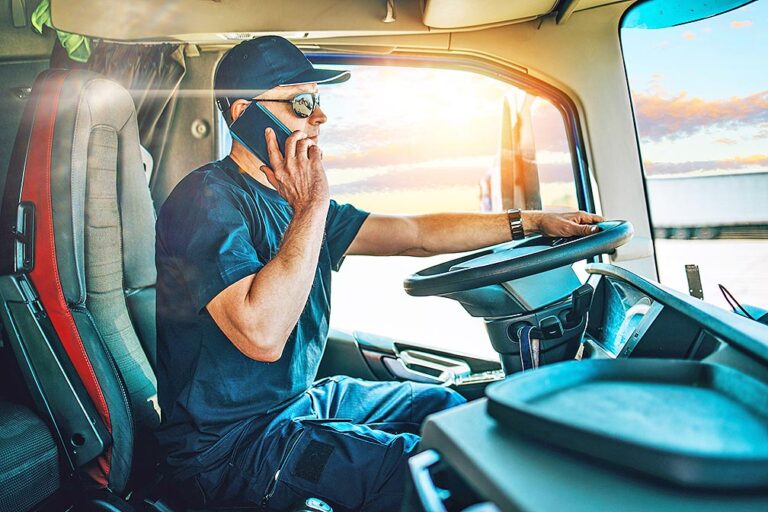WASHINGTON — The Commercial Vehicle Safety Alliance (CVSA) is petitioning the Federal Motor Carrier Safety Administration (FMCSA) to more succinctly define the meaning of “personal conveyance” in its guidelines for commercial motor vehicles (CMV).
According to a letter written by CVSA Executive Director Collin B. Mooney to the FMCSA, “to adequately clarify what the agency means by ‘personal conveyance,’ the term needs to be defined with the maximum distance and/or time a driver may operate for personal conveyance.”
CVSA is a nonprofit association comprised of local, state, provincial, territorial and federal commercial motor vehicle safety officials and industry representatives.
The current FMCSA guidance for personal conveyance states:
“A driver may record time operating a CMV for personal conveyance (i.e., for personal use or reasons) as off-duty only when the driver is relieved from work and all responsibility for performing work by the motor carrier.
“The CMV may be used for personal conveyance even if it is laden, since the load is not being transported for the commercial benefit of the carrier at that time. Personal conveyance does not reduce a driver’s or motor carrier’s responsibility to operate a CMV safely.
“Motor carriers can establish personal conveyance limitations either within the scope of, or more restrictive than, this guidance, such as banning use of a CMV for personal conveyance purposes, imposing a distance limitation on personal conveyance, or prohibiting personal conveyance while the CMV is laden.”
“Violations that are being documented likely represent only a small fraction of the instances where drivers have used personal conveyance to extend their driving or on-duty time. Establishing a maximum daily time or distance limit would allow inspectors to better identify the misuse of personal conveyance at any point in a driver’s record of duty status, improving the enforcement of the provision and reducing its use to conceal extra driving time.” — CVSA
To be eligible to log personal conveyance time as off-duty, CMV drivers must meet several conditions as outlined in the regulatory guidance on the agency’s website and noted above.
These include being relieved of all on-duty activities and responsibilities and ensuring that the off-duty trip is personal in nature.
“While these conditions present certain parameters to drivers and enforcement, the guidance it offers is incomplete because it does not provide a maximum distance and/or time that a driver can travel under the personal conveyance designation,” the CVSA letter states.
“This change adversely affects safety by allowing drivers to utilize personal conveyance to legally drive many hours beyond the hours-of-service limits and by making it difficult for inspectors to identify the misuse of the provision.”
The letter continues: “To correct this, FMCSA should add a definition of personal conveyance to § 395.2 that includes a maximum daily distance or time limit and subsequently remove the existing guidance.
“Under the current guidance, a driver could, in theory, drive hundreds of miles over the course of several hours all under the designation of personal conveyance. This presents the opportunity for increased driver fatigue and risk on our roadways, as drivers may decide to travel hundreds of miles in order to strategically relocate to an alternate location after driving a full day.”
The letter goes on to say that “without a maximum daily distance and/or time limit, the guidance presents a legal way for drivers to significantly extend their driving time and the furtherance of their load while recording personal conveyance.”
The hours-of-service limits exist to mitigate the impacts of fatigue on highway safety, Mooney wrote.
“Allowing significant extension of driving time with the use of personal conveyance undermines the goals of the hours-of-service regulations,” according to Mooney’s letter.
“In addition, the lack of a defined maximum daily time or distance makes it difficult for law enforcement to determine if a driver is genuinely operating under personal conveyance or attempting to circumvent the hours-of-service regulations.”
In his letter, Mooney contends that the guidance provides some parameters for the use of personal conveyance, all with the goal of ensuring the trip is for personal use.
He notes, however, that it is “extremely difficult to verify during a roadside inspection, particularly when the personal conveyance has been utilized on previous days and/or trips in the record of duty status, making enforcement of the misuse of personal conveyance very difficult. These challenges were exacerbated by the change in the guidance to allow laden vehicles to be used under personal conveyance. That change has opened the door for drivers to falsely claim the use of personal conveyance when they are really attempting to further their trip and extend driving time.”
CVSA initially petitioned FMCSA to make this change on Dec. 17, 2018, but the petition was subsequently denied on Sept. 18, 2020.
The CVSA says that since that time, “inspectors are seeing an increased misuse of this provision.”
“In some instances, inspectors are able to identify this misuse and cite a driver for false record of duty status,” Mooney states in the letter. “As a result, the number of false log violations are increasing. In 2021, false records of duty status violations represented the 3rd most documented driver violation, as compared to it being the 6th most frequent violation in 2019.”
In addition, in June 2021, the violation code 395.8E1PC (False Record of Duty Status-Improper use of Personal Conveyance Exception) was added to the roadside inspection software, allowing inspectors to specifically note when false record of duty status violations were a direct result of the misuse of personal conveyance.
As of Jan. 28, there were already 3,041 violations cited under 395.8E1PC, indicating the misuse of personal conveyance, according to the CVSA.
Of those violations, 61% resulted in the driver being placed out of service because their misuse of personal conveyance was an attempt to conceal extra driving time, Mooney states in the letter.
“Although this data is preliminary, it demonstrates that drivers are in fact using the vague guidance for personal conveyance in an attempt to avoid hours-of-service violations. The violation data, however, only represents instances where inspectors were able to identify and prove this misuse,” Mooney wrote.
“As noted above, it is very difficult for an inspector to prove a driver falsely claimed personal use of the vehicle if the driver is not actively operating under the personal conveyance designation at the time of inspection.”
Mooney wrote that “because of this, the violations that are being documented likely represent only a small fraction of the instances where drivers have used personal conveyance to extend their driving or on-duty time. Establishing a maximum daily time or distance limit would allow inspectors to better identify the misuse of personal conveyance at any point in a driver’s record of duty status, improving the enforcement of the provision and reducing its use to conceal extra driving time.”
In addition to drivers who intentionally misuse the provision to conceal hours, many drivers are unintentionally misusing personal conveyance because the definition and guidance are unclear, Mooney’s letter states.
“This has resulted in many safety-conscious motor carriers prohibiting their drivers from using personal conveyance to prevent violations based on their confusion of the proper use or their driver’s misinterpretation of allowable uses,” the letter continues.
“A maximum distance and/or time limit would help eliminate this confusion and allow more drivers and motor carriers to responsibly use the provision. Additionally, it would prevent drivers who misuse personal conveyance because they don’t understand the requirements from illegally extending their driving time.
The CVSA contends that by establishing a maximum allowed distance or time for personal conveyance, FMCSA “will not only eliminate confusion and inconsistent enforcement among inspectors on this issue but will also ensure safer roads as commercial motor vehicle drivers and motor carriers are on notice that personal conveyance time cannot be used as a safe harbor for driving hundreds of miles after exhausting their hours of service.”
The Trucker News Staff produces engaging content for not only TheTrucker.com, but also The Trucker Newspaper, which has been serving the trucking industry for more than 30 years. With a focus on drivers, the Trucker News Staff aims to provide relevant, objective content pertaining to the trucking segment of the transportation industry. The Trucker News Staff is based in Little Rock, Arkansas.















As a CDL driver and owner of a 100-truck operation, I am offended that the picture of the driver you chose to show is using a handheld electronic device while not wearing his seatbelt. What message is being sent? That truckers are non-complaint or CVSA members cannot properly enforce the rules of the road?
As if CDL holders needed any more rules & regs thrown at us like 10,000 monkeys on our backs! We’re already over regulated & have to jump through so many federal red tape hoops just to get products that people need from A to B. If I hypothetically want to drive my truck bobtail 200 miles to go see a freind or family after I dropped off a load. What business is that of anyone especially these pencil pushing, big brother loving, micro managing napoleon complex cubical overloards. It wouldn’t be much different if I parked my bobtail, went & rented a pickup or uhaul truck & drove those 200 miles to grandma’s. Or decided to drive 1000 miles to Vegas. But that’s perfectly fine. No issues there right?! How about instead of trying to make truckers lives unbearable these “safety” people set that “bar” to approach even 1/100th the level professional truck drivers are held to & impose some of those draconian measures onto the ones that cause and are mostly at fault when theres traffic accidents to be had. The general public & their 4 wheeled vehicles! Because just running the gauntlet every day of what many of these fools bring to the table when it comes to being a danger on the road. Its a miracle I make it home at all. But oh no. Lets not mess with regular people. Those are votes,
The sacred cow! Lets mess with the trucker. Who cares about that guy. Everbody knows they’re just a commodity, an ATM on 18 wheels just waiting to be exploited. Tbh I Don’t know why I put up with this job anymore. I must be a masochist.
I will no longer feel guilty for driving a quarter mile to use a bathroom or get breakfast when I use the personal conveyance mode. I quit the yard move mode simply because it is too easy to forget to turn it off. I did that a few times and wasn’t trying to extend or cheat the law. Senior moments happen when you get busy. The idiot cubicle sitters aren’t thinking safety as much as monetary gains. Are there cheaters? Yes. If these “safety experts” are looking for a why, all they need to do is look in a mirror if they can see past their mountain of regulations.
As for the photo used, maybe the driver was sitting at the scale and making a call to his dispatcher that the load that was late in being loaded was now going to be late in delivery.
The CVSA is quite obviously NOT asking the FMCSA for “clarity” but rather asking for additional regulations to be placed on professional drivers that are already regulated to death. The problem with the CVSA’s position is that it makes broad assumptions about what it sees as wrongful use of the Personal Conveyance provision and clearly wants tighter restrictions but has no legitimate evidence or data to back its position. Citing the number of violations and citations that have been issued and then having no actual data to rely on for its position on how much “cheating” is occurring beyond those citations is both irresponsible and untruthful, and quite frankly a blatent disregard for factual assessment in order to impose its misguided will onto others. If the Personal Conveyance provision is being abused and the number of citations is growing annually, that actual statistic proves that the system is working as intended and is not in need of “clarity” as the CVSA suggests. The CVSA perhaps should consider a bit of “soul-searching” and “self-evaluation” about its mission and purpose before attempting to create solutions to problems that don’t exist, or by taking positions on things that cannot be justified in good conscience! As an owner-operater and an American citizen I have rights. That may be disheartening for the CVSA and its liberal followers to grapple with, but that little document called the U.S. Constitution offers all the “clarity” necessary to ensure that my rights are not trampled on by my well meaning but terribly misguided fellow citizens at the CVSA! If I choose to drive my truck on my time to dinner, to do my laundry, to go shopping, to go for a joy ride, to go on a cross-country vacation, or even to go sight-seeing, what gives your organization the right to impose restrictions on the use of my property for my personal enjoyment or happiness? Shame on you for attempting to infringe on my rights for the purpose of furthering your unjustifiable agenda and for being untruthful in your quest to convince others that your position is based in facts and evidence when clearly the opposite is true! Seriously, shame on you!
This is a big issue that needs to be addressed. If you are going to write and impose regulations, then make them easy to understand by all.